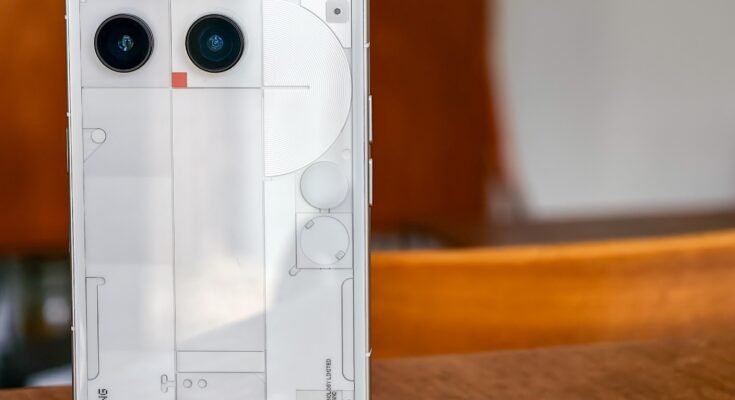Nothing says that phone 3 is his “first real flagship phone”, and he put his money where his mouth is. The phone obtains a complete American launch and $ 799, it costs exactly the same as a Pixel 9, Galaxy S25 or iPhone 16.
This makes the revision of the phone 3 refreshing, because there are only two real questions: is it as good as these three? And will it be as good as what we expect from new models of pixels and iPhone approaching?
The answer will be summed up how much you like its unique look. The bad news for nothing is that the design of the phone 3 is more conflicting than anyone, even among the biggest fans of nothing.
The phone 3 is the first phone nothing to abandon the interface of the glyphs, an abstract model of LED points and bands which became a brand of design of nothing when the phone 1 was launched in 2022. In its place, it is something smaller and more subtle: a display of circular points matrix nicknamed the glyph matrix.
The glyph matrix can display images and icons, so instead of trying to remind you of which light shows you programmed for your mom’s phone calls, you can define an emoji to represent it (you can even use a photo, but these are just as illegible as the old lights when they are rendered on the points matrix). You can use preselected conceptions of nothing or generate yours from an image, but if you want to use an emoji or a specific application icon, you will need to get the image file yourself to convert it. All this must be activated manually, contact by contact, app for the application, so it’s a bit of work to configure.
The matrix of glyphs can also do sensible things like displaying the remaining time or battery, foreign things like running a solar clock or supervising a selfie using the rear camera, and strange things like playing rock, paper, scissors or rotate the bottle. Practical or not, these are glyph toys nicknamed collectively, and you can browse them using a haptic button hidden at the back of the phone. You can define clocks or battery indicator to work perpetually as a screen form always on, which is a boring case but the best part of it for me.
The end result is a slightly more practical system than before – although it does not do much to dissipate the accusations that it is a gadget – but feels less unique, after several years of Asus Rog phones which have similar screens.
It also leaves the rest of the rear of the phone strangely naked. Many has already been written on the asymmetrical placement of the phone, but it is the sterile white space that bothers me more. The design language of nothing is all about details and doohickeys that attract the eye and refer to the material below. But here there is a group of cramped amaras and other details in the top of the phone, and below, there is a lot, well, nothing. I love the look of the other company’s other equipment, but the phone 3 is its first design failure – too busy at the top and too empty everywhere else.
Distinct design language only does the software. Nothing bone 3.5, based on Android 15, is minimalist and monochrome, with a lot of personalization – up to details such as the layout of the quick parameters menu. The gray scales is proud, although it is a little useless when you try to find an application icon in a hurry, but you can always go to the standard colored icons of Android if you prefer. A new global search bar supplied in AI also helps, drawing applications, contacts, parameters, etc.
The other major AI features are in the essential return space, triggered by a dedicated hardware key to record screenshots and vocal notes, which AI will analyze to remind you of events or tasks, with a new option to add events to the Google calendar. It can also summarize audio recordings, although you are limited to 300 minutes per month, without any option to buy more, and you only get a summary, not a full transcription.
But there is more to be flagship than looking at the room. Nothing has angry certain fans by boasting of the Snapdragon 8S Gen 4 chipset of phone 3 of the phone 3, which is also in the $ 399 Poco F7. And of course, it is a chip for the lower end of the flagship space, less powerful than the Snapdragon 8 elite that you will find in the Galaxy S25. But Google’s range of pixels has delivered less pure energy since the company went to internal tensor flea, and 8S Gen 4 is competitive with this. He has not been late or stammered during my two weeks with the phone, the processing of photos is fairly fast and he manages the game comfortably.
Some specifications are strong: 12 GB of RAM and 256 GB of storage are excellent for the basic model, offering double the competitors’ space. The 5,150 mAh battery is larger than the alternatives and lasts the day comfortably, while the 65W wire load is the fastest of the lot. The shiny OLED screen at 120 Hz is not distinguished from competition apart from being larger at 6.67 inches.
Nothing of previous cameras were competent, but that does not cut it for a flagship product. Nothing has improved phone equipment 3 with a triple rear camera that uses 50 megapixel sensors across the table – including the selfie camera – exceeding all its rivals on resolution. He indicates that he also made software adjustments, prioritizing richer shadows and natural reflections.
1/ /19
The main camera works well in good light through the twilight. Certain shots have the flat splendor of the excessive effects of HDR, by removing contrast and details, although nothing is post-treatment is more restricted than some. The results decrease once it is black, however, and the camera overexposes the strengths and crushes blacks in the process.
Telephoto is the best functionality of this camera, in part because the iPhone 16 and Pixel 9 do not have it. The color adjustment differs from the main lens, being more flat and colder, but it takes photos with a natural and natural bokeh effect, especially in macro mode.
Overall, the cameras are lagging behind behind the competition, but this telephoto lens could be a tempting reason to consider it – although with the Pixel 10 rumor goes to three cameras, this advantage could disappear.
Back to the big question: should you buy it on other flagship products? The phone 3 comes with more storage, a larger battery and a faster load. It is likely to beat the next models of pixels and iPhone on these fronts. But neither the chipset nor the cameras will follow, and there is a risk that these shortcomings will increase in the coming months.
However, none of these other flagship products looks like this. Depending on your taste, this can be a point in their favor. I don’t like the design of the phone 3. But it’s distinctive, and the glyph matrix could Be powerful if you take the time to customize it. If that calls on, the Nothing 3 phone is a unique flagship product. Just make sure you are satisfied to put the form on the function.
Photos of Dominic Preston / The Verge













